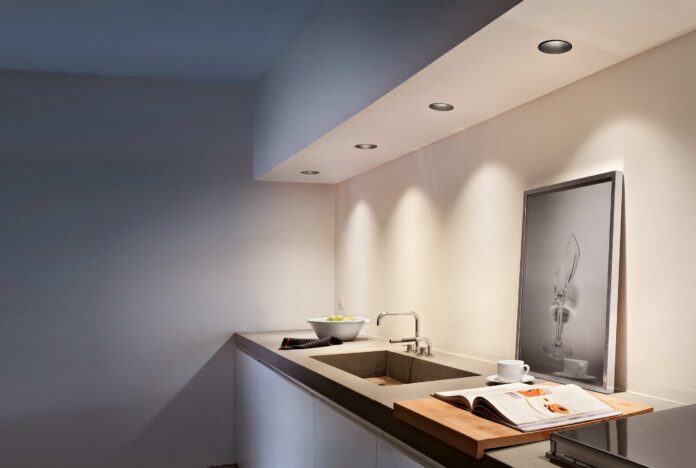Downlighters are flush-mount ceiling lights that have specific applications in certain rooms and areas around the house where other types of lighting aren’t as practical or don’t give the same effect.
Kitchens and bathrooms,in particular,sometimes need direct light that is unobtrusive, giving a clean look to a room without the need for bulky fixtures or chandeliers that don’t blend well with the surroundings. trimless downlights also typically have dimmers that can quickly alter the amount of light and change the feel or atmosphere of a room for a completely different look.
Modern manufacturers now design ceiling lights that meet quality standards for specific applications. Let’s take a look at a few of the different types and some of their characteristics.
While back the only downlights
A while back the only downlights in use were ones with standard screw-in outlets that used the large floodlight bulbs. Their inefficiency in higher electricity costs and replacement bulbs led to the development of dichroic downlighters that use halogen lamps, which last much longer and are more energy-efficient.
Two main types of downlighters exist for most applications. Mains downlights are used when more light is required, and they operate at a higher voltage (240V) and thus generate heat that is more direct. They are less expensive, but require a bigger investment in bulb replacement costs.
Then there are low voltage (LV) downlights that are often paired with a transformer to help dissipate some of that heat and further protect the circuit for more control. LV units can be set up with dimmers as well.
Common installation for downlighters
A common installation for downlighters in showers employs a mirrored glass or die cast surface that sits flush with the ceiling, while the actual bulb is recessed several inches above the ceiling. These lights require a little extra insulation and fire protection because of their proximity to steam heat and water spray that could be a significant fire hazard.
The other common use for downlighters is for accent lighting on paintings and art objects that benefit from direct light. In this way, downlights, “eyeballs,” and enclosed spotlights help separate such objects from surrounding walls and bring more character to a particular room.
The type of bulbs used in downlighters is changing over time, as traditional halogen bulbs generate carbon emissions and require more in number to produce the same amount of light – more lights required means more heat produced.
As an alternative, there are now energy efficient 12V halogen bulbs, LED downlights and CFL fluorescents that use significantly less energy and last up to 50 times longer than original halogen bulbs. LED is a new technology that is assumed to eventually replace many of the halogen installations on the market today, and some are rated to last as long as 50,000 hours.
As such, downlighters are a popular option for contemporary homes that have specific lighting schemes in mind. Their specific safety requirements and considerations, however, make them less practical for DIY enthusiasts who hope to install them on their own after a home is built.
The assistance of a qualified electrician is the most practical resource in ensuring proper placement, circuit protection, and fire safety, as well as realizing the most energy-saving benefits from installing trimless downlights in your home.
Why You Should Use Downlights In Your Bathroom
These days, the popularity of the installation of downlights in the home is on the rise due to their versatility and ability to blend into any space and décor. It is a fixture that houses the globe in the roof and sits flush with the ceiling. One of the rooms that can hugely benefit from trimless downlights is the bathroom, providing that you choose the right spots in the ceiling to install them and the right globes to illuminate the space.
There are a number of benefits for the homeowner when it comes to installing downlights in the bathroom, including:
- Ease of installation and removal: modern downlights can easily be installed by pushing them into a suitable-sized hole in the ceiling (where it is secured by clips). This also makes the lights easy to remove should work ever need to be done (to the ceiling itself or to the electrical wires stored in the ceiling).
- Range of globes available: these days, downlights can be fitted with halogen or LED globes (which allow for a pretty accurate rendition of our skin tones). These are suitable for both ambient and task lighting, depending on how the fixtures are positioned.
- Placement can create effects: some homeowners like the idea of ‘runway lighting’ (the fixtures illuminate a pathway, to the mirror perhaps), which can easily be achieved with the installation of downlights. By positioning your lights at least 3 feet into the room from the edges of the ceiling, you can also avoid the creation of ugly shadows (which it is difficult to do with other fixtures).
- Save money on electricity: if you have installed low voltage downlights in your home, you can also enjoy the added benefit of being able to lower your electricity bills. This will also help you to reduce your carbon footprint, perfect for the green homeowner.
- Adhere to regulations and guidelines: our bathrooms are subject to a number of regulations and guidelines when it comes to electricity, but downlights (luckily) are able to adhere to all of these, allowing you to make your bathroom as safe as possible.
As you can see, there are a number of benefits that you, as the homeowner, can receive after installing downlights in your bathroom. One of the biggest benefits (and one that wasn’t listed above) is that they look fantastic and are sure to show off your bathroom in the best way possible. For the most attractive lighting fixtures for your home, you cannot go past trimless downlights.







